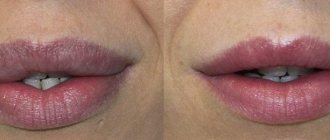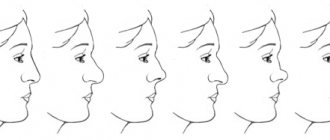Photos before and after Reviews Videos Prices Analyzes Questions and Answers
Breast surgery in the area of the nipples and areola is performed to improve the appearance of the breasts, correct inverted nipples and, if necessary, reduce the areola. Such plastic surgeries are usually performed in conjunction with a breast lift or reduction.
Photos before and after plastic surgery of inverted nipple see other photos
In what cases is nipple areola reduction recommended?
Dr. Philip Nikolaevich Mistakopulo will help eliminate the defect that is bothering you and make your breasts beautiful and attractive. You can adjust your areolas and nipple shape not only after pregnancy and breastfeeding, but also in the following cases:
- enlarged areola as a result of a congenital anomaly - tubular breast;
- congenital asymmetry in size, location or shape;
- acquired asymmetry - as a result of surgery;
- The size of the areolas is too large from a woman’s point of view, causing complexes and discomfort.
Before surgery, you must consult with a surgeon. He will examine the breasts, assess the condition of the tissues, and select the optimal correction method.
Nipple reduction technique
Nipples that become large and unsightly after breastfeeding can also be made smaller. Several options for carrying out such an operation are used.
Most often, the nipple is reduced, that is, becomes shorter, by excision of the skin from the “stem”. After such removal of the skin around the nipple, a very minor scar remains.
If such excision of the skin is not enough to obtain the desired result, then part of the nipple can also be removed - its small wedge-shaped piece. But in this case, part of the milk ducts is also cut.
How is nipple correction surgery performed?
Correction of the nipple-areolar complex is performed under local or general anesthesia. The type of anesthesia depends on the complexity of the operation: if the surgeon reduces the areola at the same time as a breast lift, augmentation or reduction, general anesthesia is performed. If you only need to correct the areolas, local anesthesia is sufficient.
To reduce the areola and improve its shape, the surgeon makes an incision along the border of the pigmented area and the skin of the breast. Then he excises the pigmented area, removing excess tissue and creating a beautiful symmetrical shape of the areola. If asymmetry is observed, the surgeon can reposition the nipple-areola complex, achieving an aesthetically pleasing result.
After correction, external cosmetic sutures and special dressings are applied. Due to the fact that the incision is made in the transition area, the surgical sutures are almost invisible. After the rehabilitation period they will become invisible.
Surgical technique for areola and nipple reduction
If the operation to reduce nipples and areola is performed as a separate surgical correction (without breast reduction, lifting, endoprosthetics), local anesthesia is used. Reduction of the areola and nipples lasts no more than 30 minutes, and the recovery of patients is quite easy. In some cases, the operation can be performed under intravenous anesthesia.
Before the operation, the surgeon applies markings to the operated area, which are consistent with the patient. During an operation to reduce the areola of the breast, the surgeon removes excess pigmented skin while preserving the natural round shape. Usually, after correction, the diameter of the areola is 4-5 cm. The scar after surgery to reduce the areola remains in the form of a thin white line, and after six months it becomes indistinguishable. If the areola is very enlarged, the surgeon may make an additional, small vertical incision towards the inframammary fold.
Nipple reduction is most often performed by excision of part of its pedicle. In rare cases, an additional wedge resection (in the upper part of the nipple) is performed. However, such correction may damage the milk ducts, so it is carried out according to strict indications.
What you need to know about the rehabilitation period
The rehabilitation time depends on the complexity of the surgical intervention. If plastic surgery is performed under general anesthesia, you will need to spend a day in the clinic under the supervision of a doctor. The very next day you can be discharged and return home.
Primary discomfort: pain, swelling, slight increase in temperature - disappears in 1-3 days. You should not shower or bathe for the first 7-10 days after plastic surgery. Your doctor may recommend special underwear for you. He will schedule dates for suture removal and follow-up examinations.
Causes of deformation
Often, nipple deformation is congenital, but much more often it is acquired over time and is a consequence of:
- pregnancy and breastfeeding;
- wearing inappropriate underwear;
- injury or previous surgery;
- breast diseases: cancer, mastitis and others;
- age-related mastoptosis;
- gynecomastia in men.
Inverted nipples may be a symptom of underdevelopment of other genital organs and/or endocrine disorders, due to which the body does not receive enough hormones responsible for puberty.
Indications for correction
The medical indication for surgery is an inverted nipple, which makes breastfeeding impossible, or Paget's disease, a very rare anomaly when malignant cells affect the nipple-areolar complex. In other cases, correction is performed for aesthetic reasons, if it is necessary to correct:
- nipple asymmetry;
- their location is too low;
- inverted or flat nipple;
- elongated or ugly shape;
- areolas stretched after feeding;
- a rough or very prominent nipple;
- very small or large size.
There is a high percentage of patients who need to correct or form a new nipple after injury or mastectomy.
In most cases, plastic surgery to correct the nipples is not necessary; it is performed solely at the request of the patients. But this is important for them, because due to the ugly shape of their breasts they experience real psychological suffering.
People often complain that they cannot have sex normally, are embarrassed about their body, and have other problems and complexes.
Rehabilitation
If only the nipples were corrected, the rehabilitation period is quite short - no more than two weeks, and the patient can go home immediately after the operation. A sterile bandage is applied to the nipples to protect them from damage and infection.
Proper breast care in the first days after surgery is very important. The bandage must be removed on the second day and the wounds must be treated with an antiseptic.
With the permission of a doctor, Contractubex or its analogues can be used to prevent the formation of rough scars.
Bruising, swelling and small hematomas are completely normal. They start to go away by the end of the first week. The process can be speeded up by following these recommendations:
- wear a comfortable bra made from natural materials;
- do not sleep on your stomach and do not squeeze your chest;
- do not touch the wounds with your hands and do not pick off the scabs;
- do not steam in the bathroom, do not visit the sauna or swimming pool;
- limit physical activity;
- completely give up alcohol and smoking;
- don't have sex.
Patients are often frightened when they discover a decrease or complete disappearance of nipple sensitivity. It usually recovers within a couple of months at most. But in rare cases, the problem remains forever.
Types of correction
Depending on what specific defects need to be eliminated, operations are divided into three categories:
- by changing the size and shape of the nipples;
- their reconstructive plastic surgery;
- breast areola correction.
The technique is chosen by the surgeon in each specific case and depends on the initial shape of the bust.
Inverted nipple
In order to maintain their functionality after correction of inverted nipples, the surgeon must have extensive experience and have high-tech equipment at hand - a good microscope and a laser scalpel. He needs to very carefully separate the connective tissue without damaging the milk ducts.
This operation is performed when the patient plans to have children and breastfeed.
If there is no need for the mammary glands to fully function, everything can be done much faster and easier. In this case, the nipple is completely separated and, after correcting the soft tissues that were pulling it down, it is set in place and secured with neat sutures. At the same time, you can correct its shape.
Nipple reduction
The consequence of surgery to reduce large or long nipples is the impossibility of breastfeeding. The only way to accomplish this is to remove their top or bottom. The remaining one is stitched into place, with the milk ducts completely blocked.
To correct a nipple that is too thick, a vertical incision is made on it and about a third of the thickness is removed. The tissues are sutured and the breasts are given an anatomically correct shape.
Sometimes the excess skin also needs to be excised, but in most cases it will tighten on its own.
Correction for gynecomastia
With a deficiency of sex hormones, men may experience noticeable enlargement of the mammary glands and very prominent nipples. This looks unaesthetic, leads to a decrease in self-esteem and the appearance of numerous complexes. So it’s not just women who do nipple correction surgery.
You can slightly reduce male breasts non-surgically by simply pumping out excess subcutaneous fat. But within a couple of years after liposuction, it will return to its place and the procedure will have to be repeated regularly. In addition, it does not affect the shape and size of the nipples.
It is possible to radically correct the breast only by removing another part of the glandular and connective tissue. At the same time, the doctor reduces the stretched areola and the size of the nipple itself, making it small and neat.
The qualifications of the surgeon are very important here, since with inaccurate work, dips and depressions can form on the chest.
Areola surgery
A fairly common type of surgery, breast areola reduction, is often performed on women after breastfeeding has ended. Many people note that the child prefers to take one mammary gland. Due to constant stretching, the areola is greatly deformed, asymmetry occurs, and the nipple becomes elongated and loose.
To make it easier to peel off the delicate skin, special injections can be made first. The excess part of the areola is cut off in a circle, and then it is sutured to the breast.
If the procedure is combined with para-areolar mammoplasty, the areola and nipple can be moved to a new position. The milk ducts remain intact and there are no problems with feeding in the future.
Preparing for surgery
Although nipple correction surgery is quite simple, it requires serious preliminary preparation. And first of all, you need to go for a consultation with a mammologist. He must conduct a thorough examination and give permission for the operation. For any active inflammatory processes in the chest, it is strictly prohibited.
In order to ensure that there are no contraindications, the patient is sent for a medical examination, which includes:
- Ultrasound or CT scan of the mammary glands;
- chest x-ray;
- general blood and urine analysis;
- HIV and RW testing;
- blood clotting test.
If all results are good, a surgery date is set. A month before, you must stop taking oral contraceptives. In two weeks - anticoagulants. You will also have to quit smoking and give up alcohol.
If you take any medications regularly: sleeping pills, antidepressants, dietary supplements, etc. – be sure to inform your doctor about this so that there is no conflict with the drugs used for anesthesia and after surgery.
Only correction of the shape of the nipples can be performed under local anesthesia on an outpatient basis. But if extensive surgery to change the entire breast is planned, then general anesthesia is used and the patient is admitted to the hospital for at least the first day.
Contraindications
Although nipple correction surgery is considered quite easy, there are also quite a few contraindications to its implementation. It is not given to minor patients, as well as people with the following problems:
- diabetes mellitus and hypertension 2-3 degrees;
- any form of oncology;
- poor blood clotting;
- systemic and autoimmune diseases;
- active viruses and infections;
- cardiovascular failure;
- serious mental disorders.
Naturally, surgery is out of the question during pregnancy and earlier than a year after breastfeeding ends.










